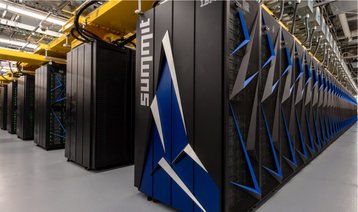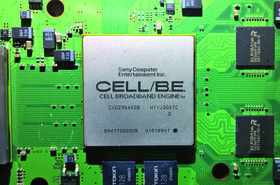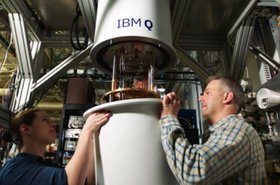The 52nd edition of the Top500 list of the world's fastest supercomputers is out, with the US securing the two top spots.
Oak Ridge National Laboratory's Summit was once again crowned the most powerful system, and even improved its High Performance Linpack (HPL) score from 122.3 to 143.5 petaflops since its debut on the previous list in June 2018.
It is joined by Sierra, at Lawrence Livermore National Laboratory, which also increased its performance from 71.6 to 94.6 petaflops, pushing it ahead of China’s Sunway TaihuLight supercomputer.
TaihuLight, with 93.0 petaflops of performance, was the world's fastest computer for two years, before being overtaken by Summit.
Both Summit and Sierra are IBM supercomputers, featuring Power9 CPUs and Nvidia V100 GPUs.
The top ten
At fourth place we have the Tianhe-2A (Milky Way-2A), deployed at the National Supercomputer Center in Guangzho, China. It performs at 61.4 petaflops after an upgrade earlier this year by China’s National University of Defense Technology (NUDT), which replaced Intel Xeon Phi accelerators with proprietary Matrix-2000 chips.
Europe's most powerful system takes up fifth place, with the Cray XC50 Piz Daint at the Swiss National Supercomputing Centre (CSCS) in Lugano, Switzerland reaching 21.2 petaflops. It features Intel Xeon processors and Nvidia Tesla P100 GPUs.
Then comes Trinity, a Cray XC40 system operated by Los Alamos National Laboratory and Sandia National Laboratories. At 20.2 petaflops, it is the only top ten system to use Intel Xeon Phi processors.
Next, at number seven, is Japan, with the AI Bridging Cloud Infrastructure (ABCI) supercomputer, found at the National Institute of Advanced Industrial Science and Technology (AIST). Built by Fujitsu, with Intel Xeon Gold processors and Nvidia Tesla V100 GPUs, it manages 19.9 petaflops.
Germany manages to come in at number eight, with the new SuperMUC-NG, a Lenovo-built upgrade at the Leibniz Supercomputing Centre (Leibniz-Rechenzentrum) in Garching. It has more than 311,040 Intel Xeon cores and an HPL performance of 19.5 petaflops. We profiled its predecessor, the SuperMUC, earlier this year.
At number nine we find Titan, once the most powerful supercomputer in the US. A Cray XK7 at Oak Ridge National Laboratory, it reached 17.6 petaflops using Nvidia K20x GPU accelerators.
Finally, rounding out the top ten, we have the IBM BlueGene/Q supercomputer Sequoia. Running at Lawrence Livermore National Laboratory, it managed an HPL performance of 17.2 petaflops.
Broader trends
While the US, and its Department of Energy, dominated the top ten, more can be learned from looking at the 500 systems as a whole.
China's share of the Top500 continued to grow, with it laying claim to 45 percent of the systems, that's 227 deployments. The US, meanwhile, hit its lowest share, with just 22 percent of the total, or 109 systems. But, with the US systems generally more powerful it reached an aggregate system performance of 38 percent, compared to 31 percent for China.
Japan came third in system share, with 31 systems, followed by the UK, with 21, France with 18, Germany with 17, and Ireland with 12.
The aggregate performance of the entire list increased to 1.42 exaflops, from 1.21 exaflops six months ago.
The top ten systems manufacturers by number of systems in the list are: Lenovo (140), Inspur (84), Sugon (57), Cray (49), HPE (46), Bull (22), Fujitsu (15), Huawei (14), Dell EMC (13) and IBM (12).
Intel provided the processors for the largest number of systems, with a 95.2 percent share. There are only three systems powered by AMD CPUs. "If you take a look at the list, 95 percent have Intel inside, that’s incredible. AMD has 0.6 percent," Top500's Professor Jack Dongarra told DCD at a panel announcing the findings at SC18.
Erich Strohmaier, the co-founder of the Top500, added: "It’s very cyclical, it takes a number of years for a new product to make an impact."
Also of note is Astra, an HPE system at Sandia National Laboratories, that listed at number 205 with an HPL Linpack score of 1.5 petaflops. It marks the very first time an Arm supercomputer has made it to the Top500, and is powered by 125,328 Cavium ThunderX2 cores. "This is the first time that an Arm system has appeared on the Top500 list," Dongarra said. "As time goes by, I expect to see Arm in a number of systems, we know of Arm in upcoming systems."
"We expect Arm to make a significant contribution," Sandia's Mike Heroux concurred.
137 systems on the list use accelerators or coprocessors, up from 110 six months ago. Nvidia makes up the majority of those, with 64 using P100 GPUs, 46 using V100 GPUs and 12 systems using Kepler GPUs (K80, K40 and K20x).
“This is a breakout year for Nvidia in the world of supercomputing,” Jensen Huang, founder and CEO of Nvidia, said.
“With the end of Moore’s Law, a new HPC market has emerged, fueled by new AI and machine learning workloads. These rely as never before on our high performance, highly efficient GPU platform to provide the power required to address the most challenging problems in science and society.”
429 of the systems have a performance above a petaflop. Dongarra said: "We guess by the next list, they will all be above a petaflop. It puts it into perspective, I remember when that was a big number."




